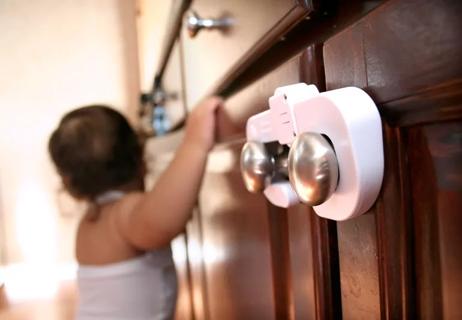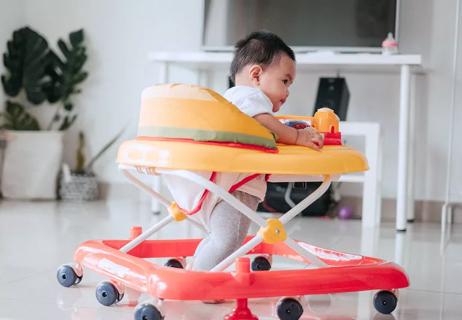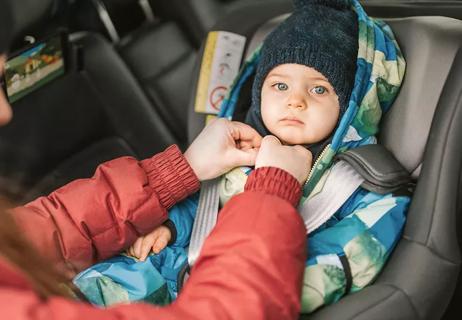Babies born preterm may need special precautions to ride safely in a car

When your baby is born preterm (“preemie”), you already have a lot to think about. What health risks should we be concerned about? How long will they need to be in the hospital? Will they even fit in their diapers?
Advertisement
Cleveland Clinic is a non-profit academic medical center. Advertising on our site helps support our mission. We do not endorse non-Cleveland Clinic products or services. Policy
And, in matters of practicality, how are we going to get the baby home? Can preemies ride in standard car seats?
Car seats are an important — and legally required in the U.S. — safety consideration for all babies and children. Most infant car seats are designed to be safe even for infants born with low birth weight. Even still, ensuring your baby is ready for the ride can be a challenge.
Babies born before 37 weeks of gestation are vulnerable little beings. And they may need special precautions to make sure they can safely ride in a car seat. Before your baby is discharged from the hospital, their healthcare team can help make sure they’re ready for that first ride home.
“Babies born preterm can have trouble breathing when sitting or reclined, like in a car seat,” says pediatrician William Mudd, DO. “Nurses and other hospital staff should be well-equipped to help make sure you can feel confident your baby will be safe in the car.”
What do you need to know about preemies and car seats? Dr. Mudd explains what to expect.
Many babies, even preemies, can use standard rear-facing car seats. Infant-carrier-style car seats usually are intended for babies who weigh as little as 4 to 5 pounds. Those weight minimums vary, however, so check your manufacturer’s instructions to be sure. Other options, like a car bed, may be recommended for some babies born preterm. More on that in a bit.
Advertisement
Additionally, you’ll want to make sure your baby’s car seat straps are adjusted to fit them well. And, as with any baby, properly installing the car seat is a must.
Dr. Mudd walks us through the considerations.
Infant car seats are designed for babies to rest at a 45-degree angle in the car. But babies born preterm may be at higher risk for having respiratory or airway problems when they’re propped up.
To be sure your preemie can safely ride in their car seat without any breathing troubles, the American Academy of Pediatrics recommends babies born prior to 37 weeks be given a “car seat challenge test” (also called a “car seat tolerance screen” or CSTS) before they’re discharged. Car seat challenges are also commonly given to babies who have medical conditions like Down syndrome or Pierre Robin sequence.
“The car seat challenge is a controlled setting that allows your baby’s hospital caregivers to monitor how they respond to sitting in a car seat,” Dr. Mudd explains. “Successfully completing the challenge can give parents and caregivers the peace of mind that your baby won’t have any medical complications as a result of being in the car seat.”
During a car seat challenge, hospital staff will place your baby in their car seat and monitor them. You’ll need to bring the car seat you intend to take them home in for the test.
Your baby will be strapped into the car seat and hooked up to monitoring equipment.
“During the car seat safety challenge test, healthcare providers will check your baby’s blood oxygen level, breathing and heart rate,” Dr. Mudd continues. “They do that by wrapping a pulse oximeter around the baby’s foot or wrist and placing electrodes on their chest.”
During the test, your baby will be monitored in their car seat for at least 90 minutes. The test may be performed longer if your drive home from the hospital is farther. Monitoring equipment will send information to your healthcare provider. After the test, your provider will look over the information and discuss the results with you.
If your baby shows signs of breathing trouble during the test, it will likely be repeated later. Your provider may also discuss alternatives to a traditional car seat, like a car bed, to bring your baby home.
A car bed allows your baby to lie flat while still being safely secured in the car. Like a car seat, a car bed can be secured to your car with a seatbelt or LATCH system. And it uses a five-point harness to keep your baby comfortable and safe. Car beds typically are designed for babies between 4 and 15 pounds. But that may vary depending on the make and model. Check the manufacturer’s guidelines to be sure.
Advertisement
When your preemie is ready to be discharged, you’ll probably get a lot (a whole lot) of instructions about how to best care for them and yourself at home. Those will vary depending on their specific medical needs.
You may also be given directions on how to keep your baby safe in the car, including any unique instructions depending on your baby’s health.
But in general, Dr. Mudd says to consider these tips to keep your preemie safe in the car:
Advertisement
Having a baby born preterm can come with a lot of questions. And unique considerations. Talk with your healthcare team, and don’t be afraid to ask about how to keep your baby safe — in and out of the car.
Safe travels!
Advertisement
Learn more about our editorial process.
Advertisement

Use these precautions to guard against tragedy

Bath toys with little holes in the bottom are more likely to retain moisture and start to mold

Keep your child rear-facing as long and possible, and ensure proper fit and installation

Install cabinet locks, outlet covers and safety gates to keep your child safe

Get the answer along with tips for safe installation

Thousands of head and neck injuries occur every year

How to know when your child’s ready to face front, switch to a booster seat and more

How to keep your little one warm and safe in the car

Babies can get congested easily, but you can calm their cough by keeping them hydrated, using nasal drops and running a humidifier

Weight loss may cause loose, sagging skin and muscle loss to your rear

Several conditions, like vitiligo and fungal infection, can cause a loss of pigmentation, leading to white spots or patches on your skin